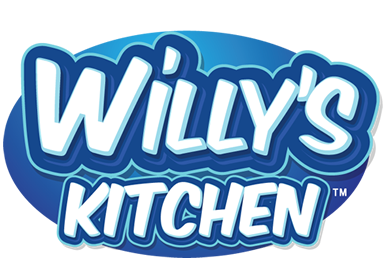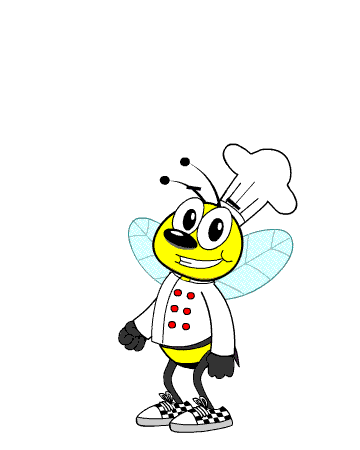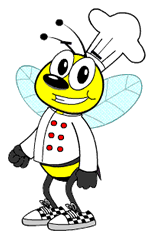Kitchen Language
Hello Kids
Are you having fun yet? I sure do!

You know, cooking with Sven and the Little Chefs taught me a lot of cool new words. Words professional chefs use when they cook!
Now when I talk to my friends I use some of these words when we talk about our lunches. Many of those words are French and my friends think I am super cool, because they think I speak French, haha.
When you look like a chef and talk like a chef … you probably ARE a chef, right?
Below I listed a few words Sven taught me. You don’t need to know them all, but they are helpful to understand when you read recipes.

Here we go:
A
Al-Dente (speak: ahl-den-tay)
Al-Dente (like “dentist) is Italian and translates as “to the tooth”. We mainly use the term Al-Dente when we speak about pasta or vegetables. Pasta or veggies should be cooked tender with still a little “bite” in the middle and not mushy. That’s when they taste the best!
Alfredo
Alfredo sauce is an Italian “white” sauce, made from cream or milk, butter, flour and Parmesan cheese. It is mostly served with pasta like fettuccine noodles or spaghettis. Roasted chicken is a favorite add-on to make a Chicken Alfredo Sauce.
Au Gratin (speak: oh-Grah-tan)
To prepare something “Au Gratin” means to cover your food with crumbled cheese and sometimes breadcrumbs and place it under a broiler (salamander), where the heat comes down from the top. Then you get a nice golden brown crust.
Probably the most famous are “Au Gratin Potatoes”, but you can use other vegetables like green beans, cauliflower or tomatoes.
Au Jus (speak: oh-Zhoo)
You have probably seen the words Au Jus in the menu of a diner and thought: “what is this?”
Well, the word “jus” is French and translates as “juice”, which is nothing else than the pan-drippings from roasted meat.
Example: When you make a prime rib (which is a big piece of beef) in the oven, the meat starts to “sweat” during the cooking process and loses water. This water is full of flavor and can be used as a sauce, which is also called “jus”.
B
Baking
This is an easy one. Who knows it?
Baking means nothing else than to cook food (in hot air) inside the oven.
Basting
When you speak of “basting” you usually speak of a big piece of meat that you roast in the oven, for example a Thanksgiving turkey.
When you cook a turkey for several hours the top can dry out easily. To avoid that you take a large spoon or a turkey “baster”, scoop some of the liquid the turkey is sitting in and you pour that over the top of the turkey about every 30 minutes. This process is called “Basting”. It prevents meat from drying out and ads flavor to it.
Beat
If you want to make something into a smooth consistency you need to “beat” it. This can be mashed potatoes or eggs, but it can also be multiple ingredients like butter and sugar when you make a cake.
You can beat something either by hand (with a whisk) or by using an electrical mixer.
Blanch (speak: blange)
If you are making a salad with vegetables and you want to soften the vegetables you need to pre-cook them. To do that put the prepared vegetables in boiling water until they get “Al Dente” (see above). Then scoop them out of the water and into ice water. Yes, ice water! This will stop the cooking process and the vegetables will keep their color and nutrition.
This process is called “blanching”. Then you put them into a colander to drain the water. You can put blanched vegetables in salads, keep them in your lunch box or have them as a snack.
Boil
To “boil” a liquid means to bring it to the highest temperature as to where it slowly turns into steam. That happens at 212 Fahrenheit. You will see a lot of bubbles rising up to the surface.
SAFETY FIRST: Boiling liquid is DANGEROUS! Please be very careful when boiling liquid is around you and always have an adult help you!
Braise
To cook healthy you want to avoid oil or butter. You can cook fish or chicken etc in a frying pan or a pot by adding liquid to it and then cover it with a lid. The hot liquid and the steam will cook your items much healthier. This is called “braising”.
Broil
You have all seen your dad’s bbq grill, right? At a grill the heat comes from the bottom and goes UP. Now, imagine you turn the grill over and the heat comes from the top, going DOWN. Then you have a “broiler” (also called “salamander”).
You can use a broiler to slow cook salmon, to get the top of your mac ‘n cheese golden brown or many other things.
Brown
This term is mostly used when you bake something, for example Pizza dough or cookies. Once they turn golden brown on the outside they will be done baking any moment.
You also speak of “browning” when you roast meat or vegetables in your frying pan to give them a nice “light brown” color.
Bruise
Beside poking your little brother in the arm and giving him a bruise, “bruising” in the kitchen means to get the nice aroma out of herbs and spices. To do that you can either rub them inside your palms or gently roll over them with a rolling pin to release their flavor.
C
Caramelize
This term is used when you melt (or “caramelize) sugar in a frying pan until it turns brown. But you can also caramelize vegetables or onions in a pan with a tiny bit of olive oil until they turn nice and golden brown. This gives them a great taste and color.
Chill
After you cook or bake something many items need to be put in the refrigerator before you eat them or further work with them. They need to be completely “chilled”.
Chop
To “chop” something means you want to make lots of little pieces out of it.
Example: fresh parsley.
Put the washed parsley on a cutting board. Then take a chopping knife and chop the parsley into tiny pieces. But please NEVER work with a knife when your parents are not around!
Coat
To “coat” something means to cover a food item with a different substance.
Example: You make chicken fingers by rolling the uncooked chicken through a bed of breadcrumbs. You are “coating” the chicken with the crumbs.
Combine
When you bake something you “combine” your ingredients in a mixing bowl. You pretty much mix your ingredients together.
Cool
After you bake your cookies or brownies, let them cool in a safe place in the kitchen before you eat them, like the kitchen counter or dry storage.
When Sven bakes brownies he always tries to hide them from me as they cool down. He hides them in a place where he thinks I don’t find them…but I always do.
Cover
To keep your food fresh or to store it in the refrigerator you need to cover it with plastic or aluminum foil. It will keep the air out and protect it from spoiling… and from bumble bees, haha!
You can also store your food in a plastic container with a lid.
Cube
To “cube” means to cut your meat or vegetables into small, cube shape pieces.
Example: Put cubes of chicken breast on your Cesar Salad. Cubes should be about ½ inch big.
D
Dash
A dash is a small amount of an ingredient.
Example: Salt. You can add a “dash of salt” by sprinkling a little bit into your mashed potatoes.
Dilute
Diluting means you are adding liquid to another liquid to make it thinner.
Example: when your sauce is too thick you can add a little bit of water or broth to make it thinner. You are “diluting” the sauce.
Dissolve
When you make lemonade and you add sugar to your lemon-water the sugar will disappear after you stir it for a while. The sugar will “dissolve” in the liquid.
Drain
Example: When you boil pasta you pour the cooked pasta into a colander to let the water drain. To “drain” means to separate liquid from solid food.
Drizzle
”Drizzling” means to slowly add liquid to other food in a thin stream.
Example: When you make a salad you don’t want to pour the dressing over the lettuce. You want to slowly “drizzle” it so it can be evenly mixed.
Dry-Fry
To dry-fry means “cooking food in a frying pan without adding any oil or water”.
Example: Breakfast bacon or sausages – The bacon’s natural oil will melt once the pan gets hot. After a while the bacon will turn crispy.
TIP: If you want to add roasted walnuts or pecans to your brownies you can also roast them this way. Nuts have natural oils so you don’t have to add more to it!
E
Emulsify
Ok, I agree, now it gets a little technical, but I still wanted to mention this one. Also I don’t know anything else with the letter “E”.
If you ever wondered why certain liquids don’t mix well, that is because of their chemical density.
Example: When you make a salad dressing you will see that water, oil and vinegar don’t seem to like each other and don’t want to mix. The way to do it is: With a whisk you combine the vinegar and water first and then you add the oil little by little to it. All of a sudden they mix. This means to “emulsify”.
I bet your dad didn’t know that one! You can probably win yourself some ice cream if you test him.
F
Fillet
You have probably heard of the term “Filet” when your dad has a barbeque, right? A filet is a very tender piece of meat without the bone, example: a salmon filet or a filet of beef.
The process of removing the skin from a piece of fish or removing the bones from a piece of meat is called, to “fillet”. You fillet the salmon.
Fold
The term “folding” is used mostly in baking.
Example: When you make a yummy chocolate mousse you carefully combine your ingredients, such as whipped cream or egg whites and melted chocolate by using a rubber spatula. So you “fold” the ingredients together.
That will keep the air inside your mixture and the chocolate mousse will stay fluffy!
Frying
We don’t like frying here, but we still want to mention it!
To “fry” something means you cook your food (meat, vegetables or some deserts) inside hot oil. Depending on what you cook this can be just a little bit of oil in a prying pan or a lot of oil in a larger pot or a specific fryer.
Frying gives your food a nice and even color and good flavor, but it also adds a lot of oil to your meal and we don’t really want that!
G
Glaze
Do you remember your last Thanksgiving? I’m sure your mom made this yummy mix out of brown sugar, honey and mustard and she took a pastry brush and she “glazed” a big piece of ham with it, right? Then she put the ham in the oven and that “glaze” turned into this super yummy sweet crust, right?!
Well, that is called a “glaze”.
Grate
When you take a piece of hard cheese and you rub it against the smaller holes of a cheese grater, then you “grate” the cheese.
You can use it to put fresh Parmesan cheese on top of your pasta! Yum!
Grease
To prevent your food or cake from sticking you want to “grease” the bottom of the baking pan with a little bit of oil, butter or non-stick spray. The word “grease” is also used to describe “animal fat” when you cook meat.
Grill
When you see your dad wearing a funny apron he usually is going to “grill” something.
On a grill the heat comes from below. Grilling ads a great flavor to your meat, because the hot iron creates grill marks, which make a great tasty crust.
Grilling is very healthy, because you don’t add any oil to your food.
J
Julienne
You speak of “julienne” when you cut vegetables.
Peel and cut your vegetables into thin matchstick size pieces for a soup or a salad. Then you have “julienne”.
K
Knead
This is a term you use when you make bread or cookie dough.
You can start by adding all of your ingredients in the bowl of your electrical mixer and then combining them gradually with a dough-hook.
Then you put this dough on the kitchen counter and you “knead” it with your hands for a few more minutes to make it smooth.
M
Marinate
To add extra flavor to meats, chicken or fish you can “marinate” (or “soak”) your food items in flavored liquid. This can be just for a few hours or even over night, depending on the type of food you are preparing.
This flavored liquid is also called “marinade” and can be made of different oils, spices or broth.
Mash
You can “mash” cooked food items by using a fork or a “masher”.
Example: After you cook potatoes use a masher to make them into “mashed” potatoes.
Measure
Measure a specific amount of an ingredient!
Especially when you are baking you need to “measure” exactly how much you need of each ingredient. It is important to always follow the recipe, otherwise your cake doesn’t turn out the way it should and you need to start all over!
Always use measuring cups and spoons.
Melt
Melting means to bring something solid into a softer or liquid form by heating it.
Example: You can melt a piece of chocolate in a bowl over boiling water. Sugar melts when you put it in hot water.
Also: Yummy ice cream melts when it’s on your tongue.
Mix
Combining different ingredients with each other is called “mixing”.
P
Peel
Removing the skin (peel) of a fruit or a vegetable, that’s called “peeling”.
You can peel carrots, potatoes, apples etc with a “vegetable peeler”.
Also, removing the skin from oranges or bananas with your hands is called “peeling”.
Poach
You can cook fish or vegetables in a pot in a little bit of liquid, such as broth or water. Place the lid on top and once the liquid starts to simmer, the steam will cook your food.
Poaching is one of the healthiest ways to prepare your food, since you don’t need to add oil or a lot of water, which would wash out the nutrition or flavor.
Puree (speak: Pew-ray)
To “Puree” simply means to take a cooked food item and to make it into mush.
You can puree something with the help of a blender, a food processor, a sieve or an electrical puree stick.
Example: Cook apples until they are soft, then “puree” them with either a blender or a puree stick to make yummy applesauce!
R
Reducing
You use the term “reducing” when you are working with a liquid.
Example: When you cook chicken broth and you let the broth boil for a long period of time a lot of steam will come out, right? That’s because the water turns into steam once it starts to boil. The more steam comes out of the pot the less broth stays inside. The chicken broth got “reduced”.
You do this to thicken a liquid, i.e. a sauce. Water reduces so the sauce gets thicker. You also have a more intense flavor.
Roast
“Roasting” means that you cook something in hot air (oven). It is similar to “baking”, but the temperature is a little bit higher when you roast something.
Example: You can put vegetables on a tray and “roast” them inside the oven. They shrink up a bit, but keep a nicer consistency as if you cooked them in water.
Roasting is one of the healthiest way to cook vegetables, because you don’t need to add any oil to them or water, which would wash out the flavor and nutrition.
You can also roast most of your meats inside an oven.
S
Saute (speak: so_tay)
Another funny word! Saute is French and means: “Sear” (or “Seal”).
Example: You want to “sear” a chicken breast in a hot frying pan.
When you want to cook a chicken breast in a frying pan make sure the pan and oil are hot enough so the pores of the meat will “seal” as quickly as possible and the chicken stays juicy. If the pan is too cold the pores won’t seal quickly enough and your chicken will get dry and without a nice golden crust.
You can also cook your favorite vegetables in a hot frying pan with just a little bit of oil or butter. Then you “sauté” your vegetables. Use a kitchen spoon to toss everything evenly.
But don’t confuse it with “frying”. When you fry something you use more oil.
NEVER work with a frying pan and hot oil/butter without your parents please!
Season
You can always add more flavor to your food by adding salt, pepper or any of your favorite spices to it. Then you “season” your food.
Score
”Scoring” means to cut little marks into the skin of your food items
There are two reasons to do this:
A – you cut little diamond shaped marks into the skin of your chicken breast before you marinate it. Through the open cuts the chicken will absorb more flavor while it is marinating.
B – you cut the same marks on bread dough before you bake it. While the bread dough still rises it will create a nicer crust during the baking process.
Shred
Similar to “grating” (see above) find the side with the biggest holes on the cheese grater. Slight your food (i.e. cheese) across to make long, thin cheese strings or “shredded cheese”.
Sift
When you bake a cake you want to “sift” your “powder ingredients” before you add them to the other items.
Flour, baking powder, powdered sugar etc often have little lumps inside of them from being in the box for too long. You need to measure everything into a bowl first and then sift everything through a “cake sifter” before you proceed with the baking process.
Simmer
“Simmering” water means that it is just below the boiling point.
You know when water boils there are a lot of bubbles on the surface, right?
Now, when you turn down the heat just a little bit the bubbles get smaller and the water less aggressive. The water is “simmering”.
Example: When you cook vegetables you want to put the vegetables in a pot with hot water with the heat on HIGH. Once the water starts to boil turn the heat to MEDIUM and let the vegetables “simmer”.
Skim
To “skim” means to scoop fat from the top of a soup.
When you make a chicken soup the chicken inside the soup will give out its natural fat once the soup gets hot (fat melts in high heat). Fat is lighter than water and it will sit on the surface of the soup. Now, to remove the fat from the soup you need to turn off the heat once the soup is done and let it rest for a while so all of the fat has a chance to rise to the top. Then you take a large spoon and you “skim” (scoop) the fat out of the soup. This process is called “skimming”.
Slice
Slicing means to cut something in very thin pieces.
Example: Place an apple on a cutting board and cut the apple into thin pieces, or “slices”.
SAFETY FIRST: You need to be very careful when you cut slices. ALWAYS have your mom or dad around to help you.
Spill
We don’t like spills in the kitchen. They are usually wet and greasy and create a slippery surface.
When something spills please clean it up immediately before someone gets hurt!
Stir
Stirring is a different word for “mixing”.
Example: With a kitchen spoon “stir” all your food items inside the pot.
W
Whip
When you “whip” something that usually means that you want to get air into your dish by rapidly beating it with a wire-whisk. The produced air will make everything very fluffy.
Example: You can whip heavy cream to make it into “whipped cream” using a whisk. You can also whip eggs before you make an omelet.
Wow, that was a lot of new words, right? Did you already know any of them? Be honest!
Like I said earlier, you don’t need to know them all, but they are helpful to understand recipes for when you cook or even just to understand a menu at a restaurant!
What cool words do you know? Please tell me so we can ad them to this list for the other kids to learn. Thanks so much!
See you soon.






